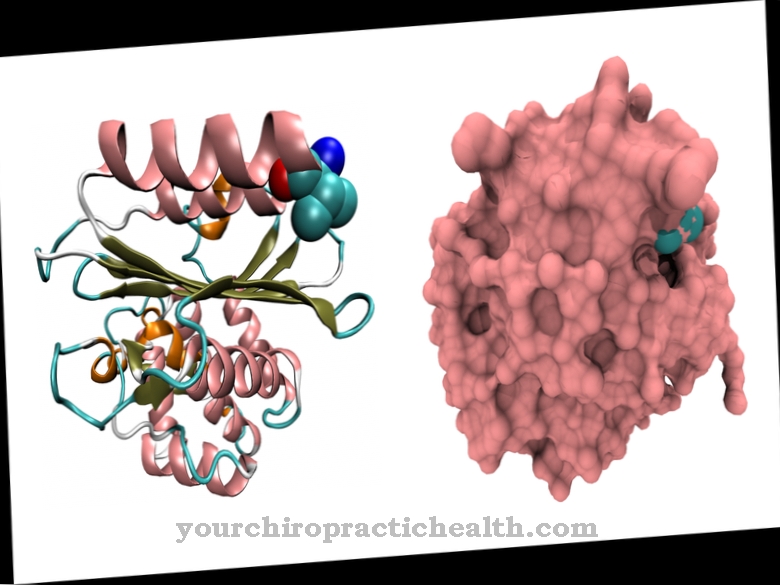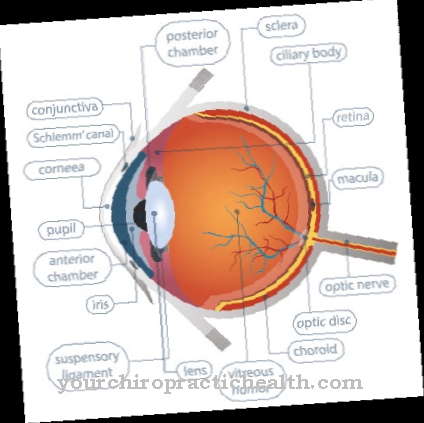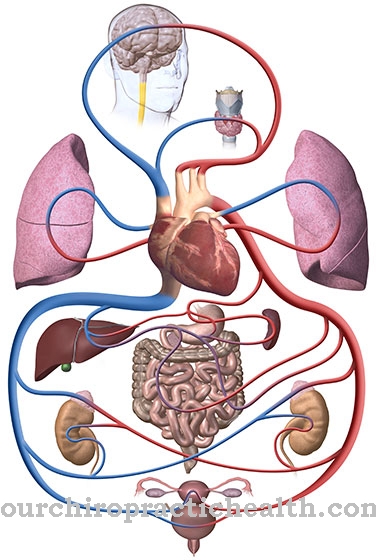At the Bulbar brain syndrome it is a complication of midbrain syndrome. This is caused by the compression of brain structures after increases in intracranial pressure within the fossa cranii media. While midbrain syndrome is mostly reversible, bulbar brain syndrome is at high risk of permanent brain death.
What is Bulbar Brain Syndrome?

© Alila Medical Media - stock.adobe.com
With the exception of the cerebellum, the brain stem comprises all parts of the brain under the diencephalon. In addition to the midbrain (mesencephalon) and the bridge (pons), the elongated medulla (medulla oblongata) also belongs to the brain stem. Bulbar brain syndrome is a total failure of the brain stem functions.
This failure can be reversible and usually results from acute bilateral damage to the pons and medulla oblongata. In most cases, the cause of the failure symptoms is an entrapment of the brainstem structures by the cerebellar tonsils. This phenomenon usually arises in the context of increased intracranial pressure and is referred to as lower entrapment.
This must be distinguished from the upper entrapment, which results in a so-called midbrain syndrome. Bulbar brain syndrome is usually a complication of midbrain syndrome. The two phenomena are therefore usually due to the same primary causes.
causes
Midbrain syndrome occurs as a result of increased intracranial pressure within the middle cranial fossa. The increase in pressure inside the skull results in the displacement of brain structures. Due to the limited skull volume, the parts of the brain can only evade to a limited extent and jam.
In midbrain syndrome, for example, the midbrain is trapped in the tentorium slit, which causes the compressed structures to fail. The causes of the triggering increase in intracranial pressure can be strokes or traumatic hemorrhage. Space demands also increase intracranial pressure. The same applies to edema and CSF outflow disorders.
The latter phenomenon is mentioned in all processes that block the draining cerebral waterways and thus hinder the outflow of cerebral water into the external liquor space. From the midbrain syndrome, the so-called upper entrapment, a lower entrapment and thus the bulbar brain syndrome develop as the intracranial pressure continues to rise.
You can find your medication here
➔ Medicines for headaches and migrainesSymptoms, ailments & signs
The symptoms of a bulbar brain syndrome are acute deficits in the brain stem reflexes. In most cases, patients with bulbar brain syndrome are comatose patients who only show hypotonic muscle tone within the skeletal muscles. Those affected also suffer from areflexia.
So the reflexes of the skeletal muscles fail. The eye muscles no longer show any reflex behavior either. Because of this, mydriasis persists. In addition, there are usually disorders of the vital functions. The respiratory drive, for example, is often reduced and results in biot or gasping breathing. The heartbeat is also characterized by bradycardia.
While there is still time for midbrain syndrome, bulbar brain syndrome is an acutely life-threatening condition that can be resolved as quickly as possible. Since the compression causes an insufficient supply of oxygen to the medulla oblongata, the central control centers can be irreversibly damaged. Such damage would result in cardiac arrest (cardiovascular failure).
Diagnosis & course
The neurologist makes the diagnosis of bulbar brain syndrome after examining the brainstem reflexes. In the event of a failure, the diagnosis is considered secure. The examination of the brain stem reflexes also allows a differential diagnostic differentiation of the bulbar brain syndrome from the midbrain syndrome.
Basically, the gradual transition from muscular hypertension in the sense of stretching synergisms to muscular hypotension is fundamental to the diagnosis of midbrain syndrome. When diagnosing midbrain syndrome, intracranial pressure must be determined. In addition, imaging helps to clarify the cause of the progressive increase in intracranial pressure.
In most cases, the neurologist will use an MRI if they suspect mid- or bulbar brain syndrome. In the slice images, for example, tumors show a relatively characteristic image when contrast agent is administered. The same goes for bleeding. The prognosis is rather poor for patients with bulbar brain syndrome. It is an acutely life-threatening condition.
When should you go to the doctor?
For bulbar brain syndrome, a medical examination and treatment must definitely take place. In the worst case, the syndrome can lead to death. However, since bulbous brain syndrome usually occurs in coma patients, no additional examination is necessary. However, a doctor should be called in if the person concerned no longer shows normal reflexes. The eyes can no longer be moved either.
Gasping or loss of consciousness can also indicate the syndrome and should be investigated. In acute emergencies, immediate treatment by an emergency doctor is necessary. If the brain is irreversibly damaged, heart failure usually occurs. The doctor should be consulted if the patient suddenly and for no particular reason no longer shows reflexes. The exam can be done by a neurologist. Treatment is unfortunately not possible in most cases, so that the person affected is dependent on a stay in hospital.
Doctors & therapists in your area
Treatment & Therapy
Up to the stage of bulbar brain syndrome, compressions of the midbrain structures are usually considered reversible. After the brainstem reflexes fail, a complete recovery of the patient is usually impossible. In patients with bulbar brain syndrome, the focus of therapy is on safeguarding vital functions.
In addition, the brain metabolism is preserved as much as possible. Ventilation is provided by means of controlled hyperventilation. In addition to catecholamines, doctors give volume substitution. The secondary treatment goal is the causal treatment, which is intended to stop the progressive increase in intracranial pressure.
The primary cause of the increase in pressure must be eliminated in order to achieve an effective lowering of the intracranial pressure ratios and thus prevent brain death. First, mannitol is given to lower the pressure. Depending on the cause, a ventricular drainage or a craniotomy may be done. During the invasive procedure, continuous monitoring of the pressure conditions and vital functions is indicated.
Intensive care monitoring is available for monitoring. The ultimate elimination of the primary cause is usually neurosurgical. In the event of bleeding, the hematoma must be removed. Causal masses require tumor extirpation.
If patients survive bulbar brain syndrome, severe damage such as apallic syndrome often remains. Supportive measures for rehabilitation are always indicated after a midbrain or bulbar brain syndrome. While these measures are relatively promising after midbrain syndrome, there are much lower chances of success after bulbar brain syndrome.
Outlook & forecast
The prognosis for bulbar brain syndrome is generally very poor, meaning that brain death occurs in most cases. The patient dies as a result of this. Death can only be delayed by symptomatic treatment, thereby increasing the life expectancy of the patient. However, a complete cure can no longer be achieved in the case of bulbar brain syndrome.
The patients are dependent on artificial respiration as part of the treatment. The pressure in the brain must also be reduced in such a way that brain death is avoided. The exact life expectancy depends heavily on the health conditions and the severity of the bulbar brain syndrome. The affected person can only survive in very rare cases. In these cases, however, the brain takes a lot of damage, so that the person concerned suffers from motor and mental limitations. These can no longer be treated and are therefore irreversible.
If no treatment is given for bulbar brain syndrome, the affected person usually dies after a short period of brain death. Before death, the patient usually falls into a coma and can no longer be addressed.
You can find your medication here
➔ Medicines for headaches and migrainesprevention
Bulbar brain syndrome can only be prevented to the extent that causal compression of the medulla oblongata can be prevented. Prevention is usually the responsibility of the neurologists treating the previous midbrain syndrome. Strict monitoring of the intracranial pressure and the effective reduction of the pressure ratios are indicated in the therapy of midbrain syndrome in order to prevent bulbar brain syndrome.
Aftercare
The options for aftercare are usually very limited in the case of bulbar brain syndrome. The syndrome itself must be treated by a doctor in order to avoid the death of the person concerned. An early diagnosis and treatment of the syndrome have a very positive effect on the further course and can prevent further complications.
The affected person usually receives medication that is supposed to lower blood pressure. It is important to ensure that they are taken regularly, and the interaction with other drugs should also be clarified. Surgical intervention is also usually necessary to fully treat bulbar brain syndrome.
After such an operation, the person concerned must definitely rest and take care of his body. Sports activities or other strenuous activities should be avoided in any case, in order to accelerate the healing process. If the bulbar brain syndrome is caused by a tumor, further and above all regular examinations of the entire body are useful in order to discover and remove further tumors at an early stage.
In most cases, however, the patient's life expectancy is limited by bulb brain syndrome. Contact with other sufferers of the syndrome can also be useful, as this often leads to an exchange of information.
You can do that yourself
Bulbar brain syndrome is a medical emergency. If it occurs, the emergency services must be alerted and first aid must be given to the person concerned.
After the treatment, the patient must first take it easy. Depending on the severity of the syndrome, a number of medicinal or therapeutic measures are then indicated. If neurological disorders occur as a result of the syndrome, this may indicate damage to the brain, which must be diagnosed in further examinations. With severe brain damage, the patient is often also in need of care and needs psychological help.
In the case of positive bulbar brain syndrome, rest and moderate exercise are usually sufficient for follow-up care. The patient should look out for any unusual symptoms and report them to the doctor. Any side effects and interactions of the prescribed medication should also be discussed with the doctor so that major complications can be avoided.
If, despite all measures, the state of health deteriorates, a neurologist must be seen with the bulbar brain syndrome. The doctor in charge can give further tips for self-help measures and thereby contribute to the fact that the bulbar brain syndrome disappears quickly.



























